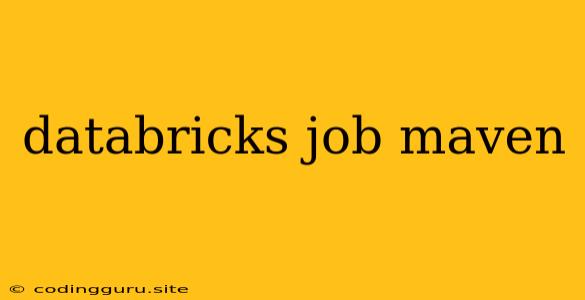Leveraging Maven to Enhance Databricks Job Management
Databricks, a popular cloud-based platform for data engineering and data science, offers a robust environment for running jobs. These jobs, encompassing tasks like data transformation, model training, and analysis, often require dependencies. Maven, a powerful build automation tool, plays a crucial role in effectively managing these dependencies within the context of Databricks jobs. This article explores how Maven can significantly enhance your Databricks job management process.
Why Maven for Databricks Jobs?
The primary reason for integrating Maven with Databricks jobs lies in its exceptional dependency management capabilities. Maven streamlines the process of acquiring, organizing, and resolving external libraries that your Databricks jobs might rely on. This eliminates manual download and configuration hassles, ensuring a smooth and efficient workflow.
Integrating Maven with Databricks Jobs: A Step-by-Step Guide
1. Configuring a Maven Project:
Start by creating a standard Maven project structure. This structure typically includes:
pom.xml: This file acts as the core configuration center for your project, detailing dependencies, build settings, and other crucial project information.src/main/java: This directory houses your Java code for your Databricks job.src/main/resources: This directory holds any necessary resources, such as configuration files or data files.
2. Defining Dependencies in pom.xml:
Within the pom.xml file, you'll define the dependencies your Databricks job requires. This involves specifying the group ID, artifact ID, and version of each dependency.
For instance, to include the popular Apache Spark library, you'd add the following snippet to your pom.xml:
org.apache.spark
spark-core_2.12
3.3.1
3. Packaging Your Databricks Job:
Maven's package goal builds a distributable artifact, often a JAR file, containing your compiled code and dependencies. This packaged artifact can be seamlessly uploaded and executed within your Databricks workspace.
4. Running Your Databricks Job:
You can now run your Databricks job by utilizing the built JAR file. This typically involves creating a new Databricks job and configuring it to use the packaged artifact.
Benefits of Using Maven for Databricks Jobs
- Dependency Management: Maven handles the complexities of managing external libraries, ensuring that your Databricks job has access to all the necessary dependencies for successful execution.
- Build Automation: Maven automates the build process, making it easier to package and deploy your Databricks job.
- Project Standardization: Maven promotes a standardized project structure, fostering consistency across different Databricks jobs and streamlining development efforts.
- Code Reusability: Maven facilitates code reuse by allowing you to package your code as reusable libraries.
Tips for Effective Maven Integration with Databricks Jobs
- Maintain a Separate Maven Project: It's often best practice to maintain a separate Maven project for your Databricks job code. This enhances project organization and reduces the risk of conflicts.
- Use a Dependency Management System: Consider using a dependency management system, such as Nexus or Artifactory, to manage your dependencies centrally and improve version control.
- Utilize Maven Profiles: Maven profiles allow you to define different configurations for various environments, such as development, testing, and production. This ensures that your Databricks job is configured appropriately for each environment.
Conclusion
Maven emerges as a powerful tool for enhancing Databricks job management. Its ability to streamline dependency management, automate the build process, and promote project standardization makes it an invaluable asset for developers working with Databricks jobs. By leveraging Maven, you can significantly improve the efficiency and reliability of your data engineering and data science workflows on the Databricks platform.
